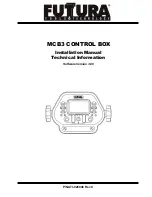
M
CB
3
Installation Manual
Page 10
Mast Mounting Options
Mast mounting locations may differ depending on machine architecture, receiver model, type of
machine, etc.
Lift & Tilt:
Traditional mounting
The traditional method for mounting dual receivers is to
mount the Lift mast and receiver (1) in the center of the
blade above the blade pivot point (2) and the Tilt mast
and receiver (3) on the end of the right hand side of the
blade.
NOTE: Without cross-coupling, a Lift error will cause an
unneeded Tilt correction which leads to instability (duck-
walking). Traditional systems slow down the tilt blade
speed to remain stable.
Turn on and set up the cross coupling to minimize the
instability and improve performance. When the cross
coupling is set, the Tilt can be ran as fast as the lift and
remain stable.
Refer to the cross coupling menus in System Setup § 5.4.
Lift & Tilt:
Wide Stance mounting option
The grade accuracy at the end of the blade can be
increased by moving the lift receiver (1) and the tilt
receiver (3) to each end of the blade. Refer to the
diagram on the following page for an illustration.
Cross coupling must be turned on. Refer to the cross
coupling menus in System Setup § 5.4.
The wide stance also avoids mast mounting near blade
king pin and linkage.
For low mounted receivers, it places the receiver grade
display in better line of sight to the corners of the blade.
This arrangement is not recommended for single laser
receiver or internal slope sensor systems.
Machine Architecture
3.2
1
2
3
X
X
V
00.00
38.00
Cross Coupling Setup Example
X
X
V
37.75
38.00
Cross Coupling Setup Example
1
2
3













































